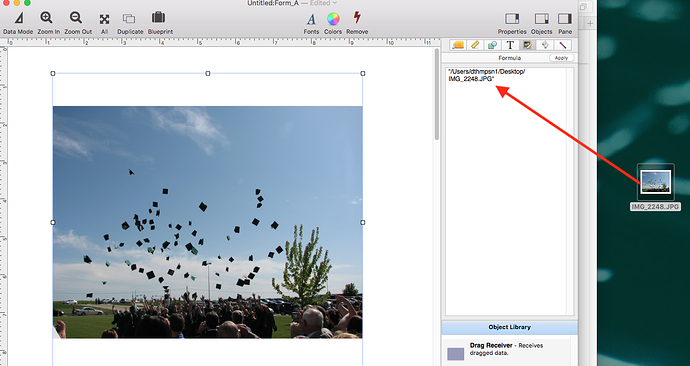The difference in these two macros is in the third parameter, which is a parameter passed to the subroutine. As far as FARCALL is concerned
"~/Data/Financial/Checkbooks/Compass Bank"
and
"Macintosh HD/Users/vicdifranco/Data/Financial/Checkbooks/Compass Bank"
are just two different text values, the FARCALL statement doesn’t care what is in the text.
So the question is, what does your subroutine actually DO with this text. Unfortunately, you haven’t given us any clue.
These text values look sort of like file paths, but normally, as Dave correctly pointed out, neither of these would work as file paths in Panorama 6. Panorama 6 does not understand the leading ~ syntax for file paths at all. Also, Panorama 6 doesn’t understand the use of slashes for file paths. Since you say these do work, you must be passing this text outside of Panorama, perhaps to an AppleScript, a shell script or perhaps shellopendocument. But I can say for sure you aren’t using this with openfile, fileload( or other Panorama 6 statements and functions that access files.
If you have access to the Panorama Intensive Training course, there is a video that covers file access.
Quick recap - this path is NOT valid in Panorama 6, but is ok in Panorama X (also valid in shell scripts, etc) –
"~/Data/Financial/Checkbooks/Compass Bank"
This path IS VALID in both Panorama 6 and X (but won’t work in shell scripts, which don’t understand colons) –
"Macintosh HD:Users:vicdifranco/Data:Financial:Checkbooks:Compass Bank"
This path is NOT VALID in Panorama 6 or X (or shell scripts). In a UNIX path, the volume name is only specified for external drives, not the boot drive (I am assuming Macintosh HD is your boot drive).
"Macintosh HD/Users/vicdifranco/Data/Financial/Checkbooks/Compass Bank"
This path IS VALID in Panorama X (but not Panorama 6), and will also work in shell scripts.
"/Users/vicdifranco/Data/Financial/Checkbooks/Compass Bank"
If you want to use the old format, DON’T CHANGE THE COLONS TO SLASHES! If you leave everything alone, Panorama X will understand it. But if you change the colons to slashes, you must use the modern UNIX format, not the old HFS (OS 9) format.
